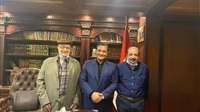Controversy of Hezbollah’s military integration in Syria (2-3)

In the first part of this study,
we discussed how the Lebanese Hezbollah became an integral part of the armed
Syrian conflict since 2011. We also referred to the integration of the party
into the Syrian war. It was motivated by doctrinal reasons for supporting the
Syrian regime, to supply him with the Iranian weapon, which is transferred via
Syria. Not to mention the military privileges granted by the Syrian regime by
providing its border training camps to Hezbollah to develop the military
capabilities of its elements.
In the second part of
the study we will discuss the repercussions of Hezbollah participation in the
Syrian war. Hezbollah involved in this war despite its full awareness of growing
the jihadist Salafist in Lebanon as an expected reaction to his sectarian
speech in Syria.
Indeed, The Sunnis go
to Syria, to fight Hezbollah elements by joining the ranks of the Syrian armed
opposition, the party fears of returning the Sunnis fighters to Lebanon with
the possibility of setting up armed militias.
We can measure the
impact of the Syrian war on Hezbollah, through a number of indicators:
First:
the Military Equipment
The change in Hezbollah’s
military and missile capabilities after its military intervention in Syria; theoretically
means that the military integration of Hezbollah in Syria has affected negatively
its military strength.
Particularly, the
reality may be different as we realize that Hezbollah is a military militia
that relies primarily on missile capabilities to pose a threat to its military
adversaries. In other words, the party’s losses with respect to its military
equipment were very limited because it did not have any tanks, armored
vehicles, or troop carriers before the Syrian war, which means that the party
managed to adapt the Syrian war in favor of the establishment of a unit of
tanks and armored vehicles.
Hezbollah exploited the
chaos of the Syrian war to develop its missile arsenal, which is the main focus
of its military power. The party sought to acquire heavy weapons to achieve a
military victory against the Syrian opposition in some cities.
The heavy weapons have
an important role in the party’s military strength in southern Lebanon against
Israel, in case the latter tries to achieve any ground invasion. Hezbollah also
smuggled an air defense systems known as SA 17, Russian anti-aircraft missile
systems.
Hezbollah also has
access to Russian missile systems known as B800 or Yakhont, its range is 300
kilometers, which means increasing the military's ability to neutralize any
threats.
In order to enhance its
missile capability, Hezbollah has been working to smuggle long-range missiles
to enable it to deepen its threat to Israel in any future war. The New York
Times reported that Hezbollah managed to smuggle a number of long-range Scud
missiles and short-range C-type missiles, as well as medium-range Iranian light
rockets and anti-aircraft Fajr rockets.
In a report in July
2017, the “Intelligence Online” newspaper reported that Hezbollah had built two
underground factories to build rockets, to produce Al-Fateh 110 rockets (which
could carry half a ton of explosives or warheads) with a range of 190 miles.
Second:
Human Structure
There are no specific
figures on the number of Hezbollah fighters in Syria. However, some estimates
suggest that the party involved elements in the Syrian fighting between 6000
and 8,000 fighters. Nearly 2000 members have
been killed and 5000 wounded.
In order to overcome the
lack of fighters, Hezbollah had to abandon the “closed recruitment policy” to
adopt volunteer fighters in its ranks. It also adopted the recruitment to fill
the deficit policy aimed primarily at increasing the paid fighters.
The above mentioned
policy reveals the awareness of the party the size of the large losses. Hezbollah
deliberately recruit the Palestinian fighters because of their street fighting
experience as an active player in the 1975-1990 Lebanese civil war.
It is important to note
here that Hezbollah has lost many of its prominent military leaders, most
notably Samir Kuntar (killed in late 2015), Hasan Ali Jafal, commander of the
elite forces (killed in September 2015 in Zabadani), and Mustafa Badr al-Din, (killed
in May 2015).







